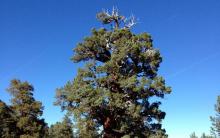The plant world often amazes with its strange beauty and wonders of pure water. All plants, which come in different sizes and shapes, are unique in their own way, but cacti are among the most amazing in the world. Protected by an outer layer of spines, cacti can withstand the harshest and most unfavorable conditions. Cacti, which rely on their incredible ability to store water as well as their thick skins to prevent water loss, are hidden deep in the driest deserts and even on the tops of some mountains. While cacti are certainly unique among other plants, some of them can be considered strange - even by cactus standards.
10. Agave or American Aloe (Agave Cactus)
Leuchtenbergia principis, known as the agave, is unique due to the straight, finger-like shoots emanating from the main stem. These "fingers" end in small groups of spines, which in older plants can develop into tangled, protective webs at the top of the plant. The agave begins to grow like any normal cactus seedling and soon develops its shoots. As the plant grows, these shoots develop into fleshy photosynthetic “fingers.” Once the shoots have formed, the agave retains its shape and simply becomes wider and stronger, remaining one plant. This is unusual because most cacti either start producing small offspring at some point, or grow some sort of "arms" in the case of tall plants.
9. Ariocarpus Fissuratus (“Living Stones”)
Cacti are associated with spines, but some species have no spines or lose them once they reach adulthood. Ariocarpus Fissuratus is an incredibly slow growing example of a thornless cactus. Some of them take up to 50 years to reach 10-12 centimeters in diameter. Being a seedling, these plants have very small, soft spines that grow from points of its geophytic structure. As the plant grows, these spines fall off and new ones do not grow to replace the original set. The result is a strange-looking, defenseless plant, which in itself seems counterintuitive for plant health. Due to a lack of protection, Ariocarpus Fissuratus grows in hard-to-reach places such as cracks and secretes small amounts of psychoactive substances to avoid being eaten by animals.
8. Astrophytum caput-medusae
The uniquely shaped "jellyfish head astrophytum" grows, as its name suggests, like the snake hairs of a jellyfish. The newly discovered Astrophytum jellyfish head was initially placed in its own category before it was discovered that its flowers, as well as the small tufts of soft, wool-like hairs found near its stem, were identical to the flowers and hairs of Astrophytum. This secured its place in the Astrophytum genus. Astrophytum jellyfish head seeds are among the largest - from 3 to 6 millimeters in diameter. The flowers of this cactus are also unusually beautiful - bright yellow with a red center.
7. Lophophora Williams or Peyote
One of the most well-known and closely monitored cacti is Lophophora williamsii, also known as peyote. It is illegal to grow or possess as peyote is known for its powerful psychedelic effects due to high concentrations of mescaline. Its use is officially limited to members of Native American tribes, as peyote has long been a central aspect of Indian rituals. According to the tribes, the use of peyote often helps to understand spirits and other disembodied entities...
6. Discocactus (Discocactus horstii)
As the discocactus matures, it develops a formation of “cephalia,” densely strewn with thorns, from which large white flowers appear and bloom. Despite the fact that in the early stages of growth the discocactus is green, over time it acquires a reddish tint. Although it looks like a common desert cactus in the initial stages of growth, discocacti grow at higher elevations, approximately 304 meters above sea level. Disco cacti are very difficult to grow due to the fact that they begin to rot if you overwater them or, on the contrary, dry out if left without water for a shorter period of time than ordinary cacti can withstand.
5. Hylocereus undatus
When it comes to flowers, cacti are not the first thing that comes to mind, even though cactus flowers can be large and beautiful. The length of the Hylocereus wavy flower can exceed 35 centimeters, and the diameter - 23 centimeters. Hylocereus undulate only blooms at night, each flower opening only once before it drops its seeds and either becomes a pitahaya or falls off and dies. The flowers give off an extremely powerful vanilla aroma that can be overwhelming when directly inhaled.
4. Pereskiopsis spathulata
Some cacti are in a fairly primitive state, and they have both leaves and thorns. Pereskiopsis spathulata is one of them: its small spines, glochidia, and leaves grow from the same place. Tropical and very fast growing in nature, Pereskiopsis spathulata is often used as a grafting base to speed up the growth process of seedlings of slow growing species. Although this plant is capable of flowering, it is very rare to find Pereskiopsis spathulata grown for its appearance or flowers. Most specimens are simply cuttings that have taken root from a mother plant, resulting in numerous clones that can also be cut and replanted.
3. Turbinicarpus subterraneus
When we think of cacti, we think of tall plants with succulent stems that are covered in spines, but (as this list has already shown) this is not always true. In the case of Turbinicarpus subterranean, the real surprise awaits below the surface of the earth. The small, bat-shaped heads are fed by knobby roots that are often the same size as the stems on the surface. This root allows Turbinicarpus subterranean to survive long periods of drought by storing large volumes of water. Being below the surface of the earth also allows it to be frost-hardy enough to withstand short periods of low temperatures as low as -4°C.
2. Obregonia (Atrichoke Cactus)
Obregonia is a separate species of cactus, also known as artichoke cactus. Like Ariocarpus and Leuchtenbergia genus, the artichoke cactus grows geophytically, in which the ends of its body spiral directly from the base of the stem. Although it has thorns, they often fall off the plant - leaving sparse tufts of thorns at the ends of limited areas of the leaf blade. This spiral growth pattern, combined with the type of trunk, gives the plant its characteristic artichoke-like appearance. Small flowers bloom at the tips of the shoots in the summer, resulting (if fertilization and ripening are successful) in edible, fleshy fruits.
1. Dwarf Blossfeldia (Blossfeldia liliputana)
Often growing between rocks in the Andes, Blossfeldia dwarf got its name from the land of Lilliputians from the novel Gulliver's Travels, where all its inhabitants were tiny compared to Gulliver. And all because dwarf Blossfeldia is the smallest cactus in the world, and its largest specimen grew up to 13 millimeters in diameter. The size and patterns that appear as they grow make these little wonders especially unique. Cacti often have rounded growing points, but Blossfeldia dwarf grows from a depression in the center of the plant. Blooming during the summer months, Blossfeldia dwarf is self-fertilized and produces seeds that are so small that they blend easily with surrounding rocks and sand.











The most beautiful motorcycles in the world
Which sea is the cleanest in the world?
Top 10 Most Expensive Furs
The largest and most luxurious casinos in the world
Knightly orders of Europe XI - XIII centuries